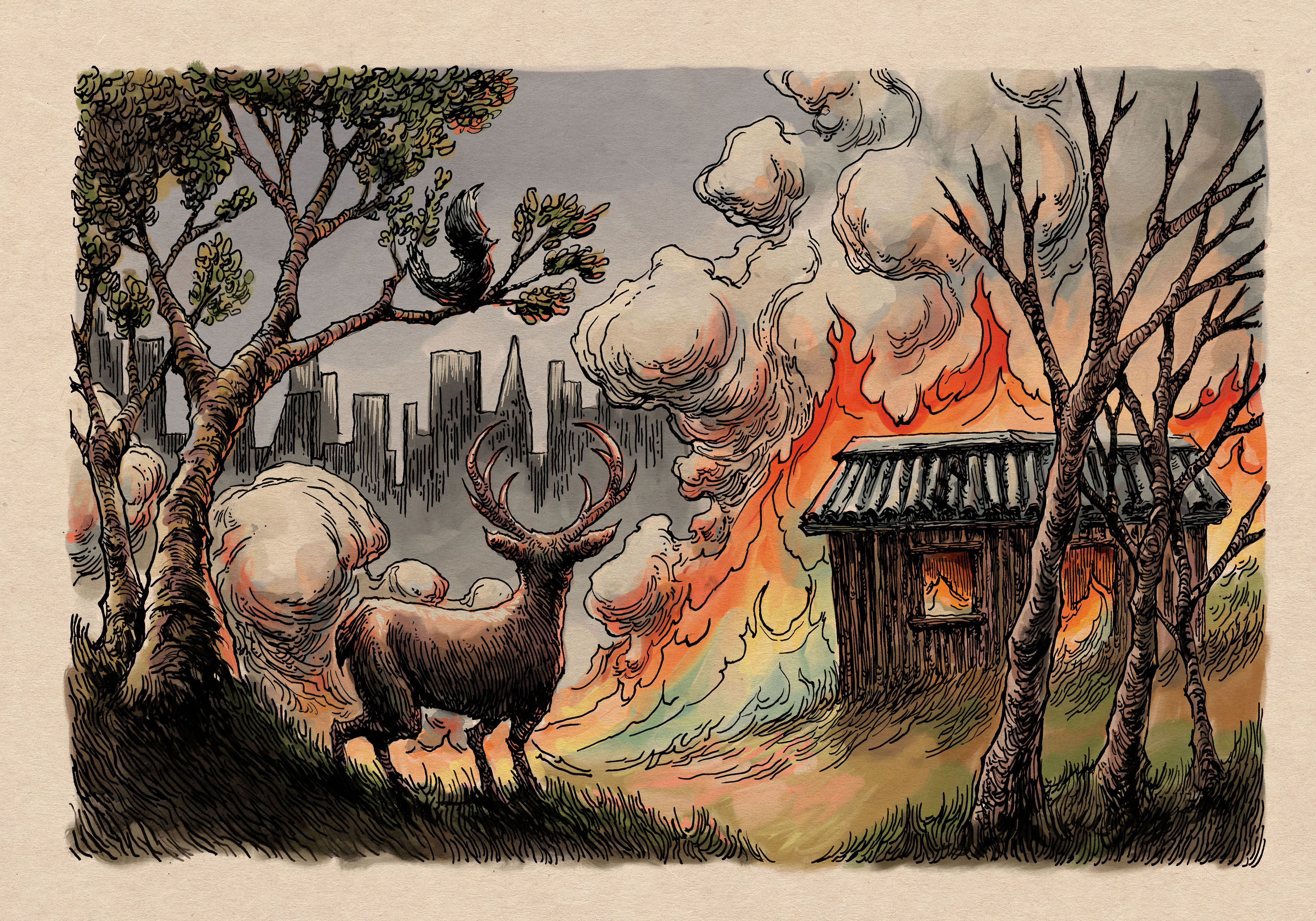“Geo-Helicoides”. Park for the restoration and preservation of native vegetation. San Agustín Basin, Valparaíso City, Chile
DOI:
https://doi.org/10.7764/plan.058.141Keywords:
Water scarcity, Fires, Native vegetation, Ecological restoration, Water device, Geothermal condensation, Hydration, InfiltrationAbstract
Climate change and human intervention have caused a year-round water shortage in the ecosystem of the ravines of Valparaíso in Chile, which has led to the degradation of its soils, the disease of its native vegetation and a significant decrease in its coverage, which in turn creates the optimal conditions for the spread of fires.
The project seeks to capture the high relative humidity (greater than 65%) by channeling the prevailing winds (southwest), which maintain an average ambient temperature of 13.9 degrees Celsius, using a 30-meter-high device (Geo-Helicoide) that will channel the air flow vertically towards a chamber cooled by the annual and constant temperatures of the subsoil (6 to 7 degrees Celsius) where it will condense the water vapor due to the temperature difference that exists between the environment and the subsoil. Finally, the water will be collected and then infiltrated into the subsoil layer of weathered granite with the aim of keeping critical points of the ravine hydrated and also, to use it together with an irrigation system in areas of influence for restoration that require immediate hydration. The main architectural project is linked to this last strategy, which is a nursery due to its role in ecological restoration and community education.
The project idea proposes identifying the most degraded areas to locate the multifunctional water device that mainly takes advantage of the phenomenon of geothermal condensation in summer and that of the coastal trough through a fog-catching system in winter to collect water throughout the year, in order to recover and maintain the stability of native vegetation from different restoration areas both by irrigation and infiltration. The objective is to increase the humidity of the subsoil in the ravines of Valparaíso, reducing water scarcity and, consequently, the probability of fires throughout the year.
Downloads
References
- Análisis territorial
Biblioteca del Congreso Nacional. (s.f.). Región de Valparaíso. https://www.bcn.cl/siit/nuestropais/region5
Gis&Beers. (2018, julio 5). Análisis de severidad de incendios con índice NBR. https://www.gisandbeers.com/analisis-severidad-incendios-indice-nbr
Servicios Climáticos. (s.f.). https://climatologia.meteochile.gob.cl/application/diario/visorDeDatosEma/330007
USGS. (s.f.). EarthExplorer. https://earthexplorer.usgs.gov
Vivero Pumahuida | Flora nativa e introducida. (s.f.). https://www.pumahuida.cl
- Estado de la técnica
Bellostes, J. (s.f.). Torres en la niebla – Coastal Fog Tower: Estudio de arquitectura. https://blog.bellostes.com/?p=8498
Carlo Rivera Cabello - Geólogo - carlorive@gmail.com. (2022, septiembre 16). Mapa de potencial geotérmico de muy baja entalpía en Chile. ArcGIS StoryMaps. https://storymaps.arcgis.com/stories/db6ca96a66e14e5988f82d11a1254d59
Coastal Fog Tower 3. (s.f.). http://www.albertofernandez.cl/?p=1445
Chat GPT. (s.f.). Geotermia, Enfriamiento Geotérmico, Termodinámica. https://chat.openai.com/c/0360b4fe-07ed-4c7e-a6f6-1973e8960c7e
Delgado, R. (2023, abril 17). ¿Qué es y cómo funciona el enfriamiento adiabático? Canal Gestión Integrada. https://www.inesem.es/revistadigital/gestion-integrada/enfriamiento-adiabatico
Evm. (2022, julio 6). Climatización geotérmica. Utopía. https://utopia.engineering/que-es-la-climatizacion-geotermica
Futurism. (2016, octubre 31). This wind turbine can produce water out of thin air [Vídeo]. YouTube. https://www.youtube.com/watch?v=0opeZLY0sno
Geotermia vertical. (2018, febrero 13). Climatización geotérmica. https://www.geotermiavertical.es/climatizacion-geotermica
Profesor PUCV y Geógrafo Luis Álvarez. Consultas sobre Geotermia.
Profesor UDP e Ingeniero Hidráulico Alonzo Pizarro. Consultas sobre condensación y evapotranspiración.
REHAU. (s.f.). Pozo canadiense: qué es, ventajas y desventajas. https://www.rehau.com/es-es/pozo-canadiense#:~:text=El%20principio%20b%C3%A1sico%20del%20funcionamiento,el%20interior%20de%20la%20vivienda
Ren Morgado Arquitecto. (2021, noviembre 2). Manipulación del viento en arquitectura [Vídeo]. YouTube. https://www.youtube.com/watch?v=-YVSOC16Mgk
Yakka. (s.f.). https://cl.socialab.com/challenges/cmcm-hechoenchile/idea/42375
- Estado del arte
Brillembourg, D. (2019, septiembre 8). David Brillembourg: Las Torres del Viento en Irán, arquitectura sostenible con materiales naturales – Antonello Sacchetti. https://davidbrillembourg.wordpress.com
Carretero Hernández, L. (2016, septiembre 5). 08. Las torres de viento [Vídeo]. YouTube. https://www.youtube.com/watch?v=jjQlXyMGaFQ
Solar Zasa Design. (2020, noviembre 2). Cómo pagar menos luz en casa = Torre de Viento [Vídeo]. YouTube. https://www.youtube.com/watch?v=IKp4oTxsm5w
Stouhi, D. (2024, marzo 7). ¿Qué es un captador de viento tradicional? ArchDaily en Español. https://www.archdaily.cl/cl/971322/que-es-un-captador-de-viento-tradicional
- Variable cuantitativa
Chat GPT. (s.f.). Cálculo de la condensación del agua basada en principios termodinámicos y relaciones atmosféricas estándar. https://chat.openai.com/c/d2b96e0a-d3a3-4ac0-a480-410b6800003b
Ingeniería elemental. (s.f.). https://www.ingenieriaelemental.com/posts/carta-psicrometrica-online
Noguera, I. B. (2020, septiembre 7). ¿Qué son las cartas psicrométricas? Ingeniería Química Reviews. https://www.ingenieriaquimicareviews.com/2020/09/cartas-psicrometricas.html
Profesor PUCV y Geógrafo Luis Álvarez. Consultas sobre datos del subsuelo.
Profesor UDP e Ingeniero Hidráulico Alonzo Pizarro. Consultas sobre el cálculo de condensación de agua.
Servicios Climáticos. (s.f.). https://climatologia.meteochile.gob.cl/application/diario/visorDeDatosEma/330007
- Materia vegetal
Departamento de Medio Ambiente, Biodiversidad y Acción Climática, Gobierno Regional Metropolitano de Santiago. (2023, marzo). Guía general “Criterios de sostenibilidad en eficiencia hídrica y energética, para la formulación de iniciativas de inversión en espacios abiertos”. https://www.gobiernosantiago.cl/wp-content/uploads/2023/05/0.-GUIA-GRAL-CRITERIOS-SOSTENIBILIDAD.pdf
Luebert, F. & Pliscoff, P. (2017). Sinopsis bioclimática y vegetacional de Chile. Universitaria.
Magrini, C. (Dirección general). (2014). H30 Valparaíso. Editorial Magíster Territorio y Paisaje, Santiago de Chile.
Magrini, C. (Dirección general). (2015). H30 Quebrada. Editorial Magíster Territorio y Paisaje, Santiago de Chile.
Magrini, C. (Dirección general). (2016). Valparaíso H30 Infiltración. Editorial Magíster Territorio y Paisaje, Santiago de Chile.
Magrini, C. (Dirección general). (2017). Valparaíso H30 Sistema científico. Editorial Magíster Territorio y Paisaje, Santiago de Chile.
Magrini, C. (Dirección general). (2021). Valparaíso H30 Humedad. Editorial Magíster Territorio y Paisaje, Santiago de Chile.
Ministerio de Agroindustria, Provincia de Buenos Aires. (2018, marzo). Manual de vivero. https://www.argentina.gob.ar/sites/default/files/manual_de_vivero_2do_ano.pdf
Downloads
Published
How to Cite
Issue
Section
License
Copyright (c) 2024 Revista Planeo

This work is licensed under a Creative Commons Attribution-NonCommercial-ShareAlike 4.0 International License.


